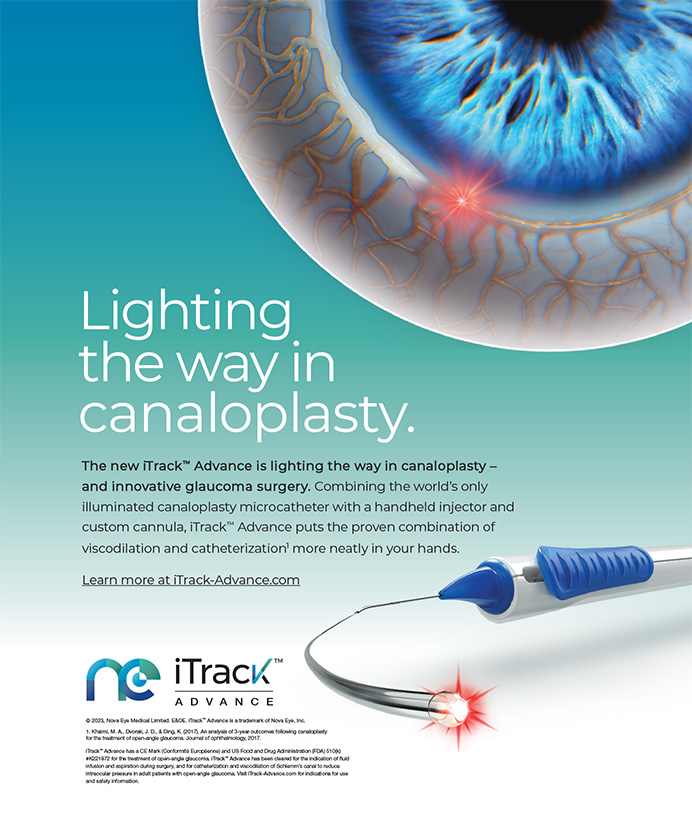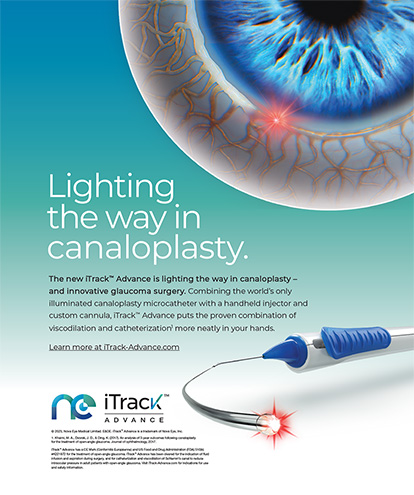A hypermature cataract becomes white when degenerating cortex reaches a hyperosmotic state inside the capsule and draws in fluid. This process leaves a very tense capsule and a heavy nucleus that often sinks in the gelatinous and fluid cortex (Morgagnian cataract). Because the white nucleus can be quite hard, complications are unfortunately common, unless the ophthalmologist has prepared well for the case in advance. The potential pitfalls when performing cataract surgery on these eyes are
- difficult visualization of the capsulorhexis against a white background and the release of milky cortex with no red reflex
- extension of the capsulorhexis upon opening of the capsular bag (Argentinian flag sign)
- a freely mobile nucleus that is hard to hold in place and difficult to remove with typical maneuvers such as divide and conquer
- a hard nucleus with no protective cortex or epinucleus
This article offers advice on handling the aforementioned challenges.
POOR VISUALIZATION
Fortunately, today, capsular staining has greatly aided the creation of the capsulorhexis in eyes with a hypermature cataract. I routinely stain the capsule (usually with trypan blue) in all such cases under Healon5 (Abbott Medical Optics Inc., Santa Ana, CA). Specifically, I inject the dye into a layer of balanced salt solution that rests just above the capsule. Then, I carefully create the capsulorhexis through the sideport incision with microcapsulorhexis forceps in order to keep the cortex from flowing out of the capsule and either obscuring my view or causing a peripheral extension of the capsulorhexis.
If making the capsulorhexis with a microforceps through the sideport incision seems a daunting task, then the surgeon should be prepared as soon as the capsule is open to aspirate some of the milky cortex in order to alleviate capsular pressure and minimize the spread of the milky cortex that obscures visualization. I am reluctant to use this approach any longer, however, because an extension of the capsulorhexis can result no matter how fast I move to aspirate cortex, and I often have to repeat the aspiration as more cortex flows out of the bag and blocks my view.
EXTENSION OF THE CAPSULORHEXIS
An extension of the capsulorhexis due to capsular tension can turn a routine case into a disaster, as the nucleus and remaining lenticular material drop into the vitreous cavity. Understanding the cause of the problem is the key to avoiding it. An opening in a tense capsule within an intraocular chamber of zero pressure will cause viscous cortex to surge out of the capsular tear and extend it. Of the many strategies for managing this situation, I find it easiest to perform a capsulorhexis with a 25-gauge forceps (many excellent versions of this instrument are available, including one from Microsurgical Technology [Redmond, WA]) through the sideport incision before making my primary incision.
I work through a sub-1-mm incision and use highly viscous Healon5 to inflate the anterior chamber to an increased pressure that is at least equal to that of the internal capsular pressure. As the anterior chamber inflates, I can see the capsule flatten. Once the pressure in the anterior chamber equals the pressure inside the capsule, an extension of the capsulorhexis simply cannot occur. The advantage of this approach, in my experience, is that Healon5 cannot escape through a stab incision. In contrast, the loss of viscoelastic through a regular incision during the capsulorhexis is common and can result in the tear's extension and/or visual obscuration by milky cortex (Figure 1).
This approach requires the ophthalmologist to have experience in using a microcapsulorhexis forceps through a small stab incision. He or she should remember that the wound must serve as a fulcrum for all of his or her actions. Otherwise, the eye will move, and corneal folds will result. If they take their time, surgeons should find that the procedure is quite intuitive.
A MOBILE NUCLEUS
With no solid or semisolid cortex or epinucleus to stabilize the nucleus, creating a groove is almost impossible. The high flow and vacuum in a stable chamber that are possible with today's phaco machines make aspirating and impaling the nucleus with the phaco tip a straightforward proposition. I also find the 0° tip helpful, because the nucleus, once aspirated, does not angle off from the tip, and I can impale it with the tip pointing toward the opposite pole. I typically use micropulsed longitudinal ultrasound under these circumstances to minimize chatter. I use enough energy to impale the nucleus up to the phaco tip's sleeve, which I have rotated back to expose 2 mm of the tip.
With vacuum set at 300 to 400 mm Hg and the nucleus impaled (I hold on to the nucleus with maximum vacuum), I perform horizontal chopping using an instrument that reaches across to the opposite pole to split the nucleus into two fragments. I aspirate either heminucleus with the assistance of a second instrument to manipulate the fragment so I can impale it on the cut edge and, again, cut off a small fragment (Figure 2).
Transverse ultrasound works well for emulsification, although I prefer micropulsed ultrasound. I use the chopping instrument to push the fragment into the phaco tip and crush the material slightly between the two instruments. Little ultrasound is needed, and the piece is rapidly subsumed. I repeat the process and keep the fragments small (the harder the nucleus, the greater the number of fragments) until the nucleus is gone.
Usually, I can remove hypermature cataracts easily in this manner, and patients' corneas are clear the next day. Because what little cortex or epinucleus is present is usually rapidly aspirated, I like to work midchamber and away from the posterior capsule. As a safety measure, I always position my chopper between the nuclear fragment and the posterior capsule when removing the last pieces. Another precaution is to float all of the nuclear fragments on a dispersive viscoelastic layer to protect the capsule and to replace the same viscoelastic in the corneal vault as often as needed to protect the cornea, as taught by Roger Steinert, MD. Fortunately, hypermature cataracts tend to be brittle with little or no woody connections between lenticular fragments. Although they can be quite hard, they chop up very nicely and tend to cleave cleanly.
CONCLUSION
Capsular staining, Healon5, a microcapsulorhexis forceps placed through a small sideport incision, modern phaco fluidics, a 0° tip, and horizontal chopping render surgery on hypermature cataracts straightforward for the prepared ophthalmologist. In my opinion, these nuclei are easier to manage than hard brunescent cataracts.Ên
Randall J. Olson, MD, is the John A. Moran presidential professor and the chair of the Department of Ophthalmology and Visual Sciences, and he is the CEO of the John A. Moran Eye Center at the University of Utah School of Medicine in Salt Lake City. He is a consultant to Abbott Medical Optics Inc. Dr. Olson may be reached at (801) 585-6622; randallj.olson@hsc.utah.edu.


